Rudy Rucker's Blog, page 53
January 17, 2011
The Hollow Earth Online Now
My novel The Hollow Earth is now online for free download under a Creative Commons license, in ePub, PDF, and HTML formats.
January 13, 2011
Reading in SF. New Outline. Ripping Vinyl.
Upcoming event: I'll be reading from my forthcoming memoir, Nested Scrolls at 7 PM this Saturday night, January 15, 2011, in San Francisco at the SF in SF gathering in the Hobart Building on Market St. near Montgomery St. and 3rd St. Diana Paxson will be reading as well.

My writing is moving slowly this month. It's taking some time to ramp back up after the Xmas break. Also I pissed away days and days tweaking my music collection on my computer for my new iPhone, and coming to terms with the obtuse and balky iTunes music management software. And blogging about it, God help me. As an on-going part of the process, I'm "ripping" some vinyl records to files. Converting analog to digital, which is, of course, a good analogue for my lifebox-and-Ware-Tetralogy Digital Immortality kick. I have a brief guide to ripping vinyl at the end of this post.
One cool thing about my novel-in-progress, The Turing Chronicles is that it shows Alan moving against the tide, that is, he's going from digital computers to analog biocomputations. But the more relevant thing is that it shows something computational (the skugly biocomputation) becoming symbiotic with human life (like people carrying smart phones).

I remain unsure about the over-all plot, which is hanging me up. When I'm lost sat sea in the middle of a book, I fall back on what we used to call "paper-shuffling." That is, I play with organizational matters. Tidy things up. It's like—when I lose my wallet, glasses or keys, I can often find them by cleaning up my whole office.
I've also been firming up my ever-evolving conceptions about the skugs and their origins, and this involves revisions. It seems a bit much to suppose that the skugs have really strong personalities, as they're just AI-tweaked networks of biocomputations. I need to keep reminding myself that they're not alien invaders. This said, I do have the possibility of giving the skugs a hive-mind personality that's to some extent based on what they pick up over radio and TV signals. This could be a correlative for, e.g., the hive minds you see if you study Twitter or Facebook or Google search results.
Looking ahead, I had been planning to add in a higher level of reality populated by dreamskugs, effectively a second race of odd critters. But yesterday in the car, driving up to Berkeley with my wife, I was telling her about my plans for the book. And when I got to the dreamskugs, she was like, "What!? Don't do that again, Rudy! One kind of creature is enough. Don't always overdo it." And she's right.

It boggles the mind to think about how many kinds of critters I jammed into each of my last three novels, that is, Postsingular, Hylozoic, and Jim and the Flims. It's okay and maybe even good that I packed those books with alien eyeball kicks, but it's a baroque high-SF supercartoon style that I'd like to get away from for The Turing Chronicles. I'd like to see novel one be a more stripped-down. Like a 1950s black and white SF invasion movie. Like Them or the originals of The Fly or The Invasion Of The Bodysnatchers.
But way of opening up my mind to a new conception fo the novel, I moved my former outline into a new "False Paths" section of my notes for the novel. As I discuss in my free "A Writer's Toolkit" on my writing page, having this kind of data repository means that I feel less constrained in making brutal cuts and changes to the old outline (or to the text). And thus, today I managed to rewrite my working outline, which is something I've been wanting to do for a month. It's the kind of job that only takes an hour or two when you do it—but getting your head in the right place for the job can take weeks or months.

And now a word from our lord and master, the computer. I've been delegated to make a long story short on the subject of ripping vinyl. By the way, the first album I ripped was the first one I ever bought, Go Bo Diddley, purchased fifty years ago when I was 14. "Crackin' Up." [Apparently people can post copyrighted songs on YouTube because the users don't get to keep the song, they only get to listen to it stream from the site.]

(1) You can use a regular (non-USB) turntable, but it's advisable to have a little pre-amp box about the size of a pack of cigarettes. The turntable sends two plugs into the pre-amp, and you run two lines out of the pre-amp. You need a two-to-one connector to hook the pre-amp to your computer. This can be the same connector that you might use to plug your one-socket iPod or iPhone into the two stereo input jacks of a living-room sound-system amplifier.
(2) You use the two-to-one connector to run from the pre-amp into the "Line In" jack that you can find on the exposed back of your sound card on the back of your desktop computer. Most laptops don't have a Line In jack. You don't want to use a "Microphone" jack, as that won't pass the stereo through.
(3) You get the free software Audacity for Windows , Linux or Mac. You fire up Audacity and click on the round button to start recording. At about the same time you put your needle onto your turntable and let your record play. You can set Audacity to pass sound out to your computer speakers. See the Audacity help files for help on recording a record on your computer.
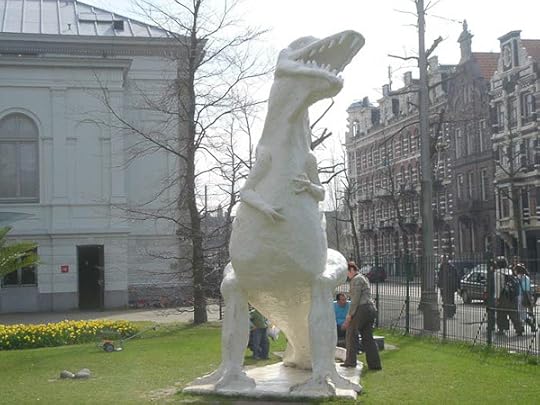
(4) Tape both sides of the record into a single sound track. You might want to run the Effect | Click Removal and maybe Effect | Normalize to clean up your track. Now to save as separate songs. You have to show Audacity where the breaks between songs are, see the Audacity help on this. The easiest way to do this is by hand, inserting labels. There's an automatic Analyze | Find Silences control you can use, but it doesn't work very well because vinyl really never is silent anywhere. So I put the labels in my hand, sometimes looking at the song list on the album to make sure I get the right count. Don't bother putting song names in the labels, you can do that automatically later one. You save the recording into separate files, one for each song. You can use the "Export Multiple…" command, sending the files into a reasonable directory like Music\Bo Diddley\Go Bo Diddley. And tell Audacity not to ask you about each song. Typically you save them in a fairly high quality MP3 format. Don't close your Audacity project file until you're sure that everything exported properly and is in good shape.
(5) Open your newly created directory of (still unnamed) mp3 files with (if you're a Windows user) the tool mp3tag. You can set the album name and artist for all the files at once yourself. And then you can use the album name and album artist to get mp3tag to look up and install the track name metatags for you. And it can copy these metatags onto the file names. I don't know what the best free Mac tool for this is, you can find a list of some apparently free options on Softonic.
(6) Use the File | Add Folder to Library… selection in iTunes to bring your new files into iTunes. You can find a nice album cover with a quick Google image search and paste it into place.
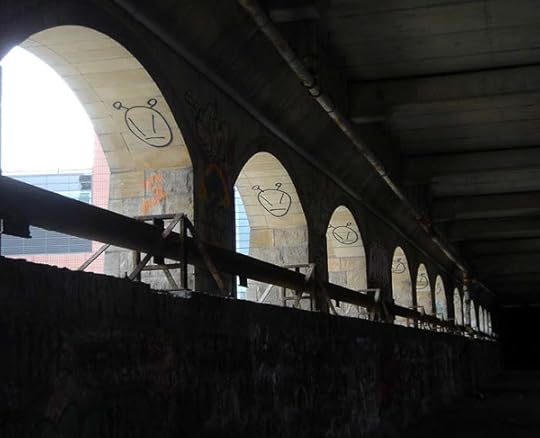
See some of you Sat nite, I hope.
January 9, 2011
Digital Immortality Again
So, cool, I got a passing mention in the Sunday New York Times Magazine today in an article by Rob Walker, "Cyberspace When You're Dead," about various kinds of digital immortality.
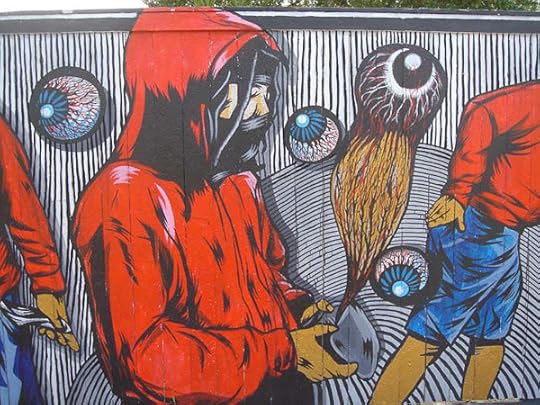
[The illos in today's post, for reasons which will become clear, are my photos used to illustrate a story by Mac Tonnies, "One Hundred Years" which appeared in issue #3 of my online zine, Flurb. Some of the photos are from other stories in the same issue #3. By the way, I'd love to know the name of the artist who painted the wonderful street mural shown above.]
As regular readers will know, I've written about themes of software immortality in several contexts. To start with, the four novels in my Ware Tetralogy deal with the notion of copying someone's mind to another platform. The collection is available in print, as a commercial ebook, and as a free CC ebook.

I coined the word "lifebox" in a short story, "Soft Death," which appeared in The Magazine of Fantasy and Science Fiction in September, 1986. I used it to mean a digital or online simulacrum of a person. I go into considerable detail about the lifebox in my novel, Saucer Wisdom, in my non-fiction book, The Lifebox, the Seashell, and the Soul, and in my 2009 article "Lifebox Immortality" which I co-authored with Leon Marvell. This article has also appeared in a recent issue of h+ magazine.
In a nutshell, my idea is this: to create a virtual self, all I need to do is to (1) Place a very large amount of text online in the form of articles, books, and blog posts, (2) Provide a search box for accessing this data base, and (3) Provide a nice user interface.
I made a first crude stab at this a month ago, with my Rudy's Lifebox page. This page lets you Google-search my rather large www.rudyrucker.com site.

The "test subject zero" discussed in today's Times magazine article is Mac Tonnies, who died this year. I was one of Mac's numerous online friends—you can find the exact extent of this by typing "Mac Tonnies" into the Search box on the Rudy's Lifebox page mentioned above. Most of the hits are to posts which have comments by Mac at the bottom. And, as mentioned in the caption to first illo on today's post, I published one of Mac's stories in my webzine.
As the Times article discusses, some friends of Mac's have kept his Posthuman Blues blog alive as a kind of lifebox. Note the slightly ominous final post, although Mac liked these kinds of images, so really they aren't all that ominous in the context of his blog.
The Times article is a harbinger of a trend I've been predicting for some time: there's going to be a small industry based on people building digital memory-shrines for themselves. The Nokia phone company had an early entry into this sweepstakes with their Lifeblog package, but that's gone now, so far as I know. More recently, I noticed that Hallmark Cards is getting into "memory-keeping products." And everyone's heard of Microsoft's Gordon Bell and his MyLifeBits project.
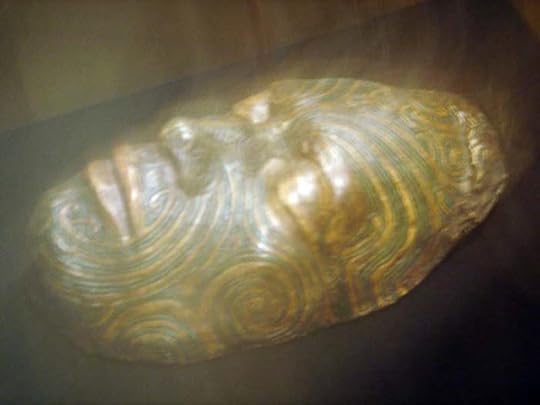
Some of the links in the Times article are for companies like Entrustet that serve as digital repositories for your "lifebox" data such as online photos or collections of your writings. At this point, some of these services are primarily about cloud-based data-storage, kind of like Carbonite with an immortality spin. These services are expensive, though, and often involve a monthly fee—which you're likely to stop paying a few years before you die.
Another company, Deathswitch, will send post-mortem messages to people from you! How do they know when to send the messages? When you stop answering their emails and/or, presumably, when paying the bills they send you. It's easy to imagine some tragicomic scenarios here—a guy writes angry "Aren't you sorry now" messages, forgets about it, lets the account lapse. Actually, the idea for the company is grounded on a short-short story "A Brief History of Death Switches" by the company founder David Eagleman.
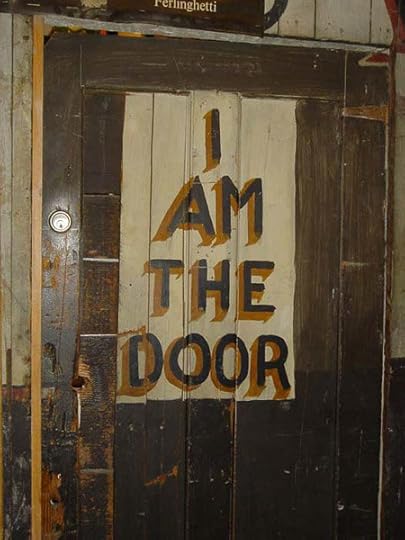
Back to digital immortality. One way to create a lifebox is, like Gordon Bell, just to save everything you type and photograph everything you see. Another way is to become a writer and to craft a memoir. People in search of shortcuts will turn to companies who purport to help them. A couple of links from entrants into this sweepstakes: LifeNaut and Virtual Eternity. This exercise quickly turns kind of creepy, veering into the Uncanny Valley.

Clearly what's needed is some solid shareware to layer onto something resembling Google Search. I wrote a little about this in my post on "Chatbots," and in the comments on the post.
Actually, as the years go by, this whole enterprise of digital immortality seems less important to me than it used to. By now I'm kind of okay with passing away. And, with or without high tech, I'll be leaving some printed books behind and, even closer to my heart, my children and grandchildren. That oldschool wetware immortality…
January 4, 2011
Managing Music in iTunes for Free, Ver. 2
I originally put up this post on January 4, 2011, and now, on January 8, 2011, I'm reposting a Version 2 of it. In the mean time I've learned about some good free tools for Windows, and I've changed my mind about some issues.

[This post is illustrated with a sequence of non-computer-related photos that I took around Los Gatos and Santa Cruz recently. It's been raining a lot lately, and now the sun is out, and today it was like a cool spring day.]
Prolegomena
This year I made a simple New Year's resolution. I'd finally rip my vinyl to digital files. I've got a few hundred favorite old LPs in my living room, and I want to hear them on my iPhone.
I've been embroiled in this for a couple of weeks, and I'm going to write (at least) two heavily geeky posts about it. This, the first post, "Managing Music in iTunes for Free," is on the general topic of organizing your music in iTunes, mainly focusing on the Windows platform. And the second post, "Ripping Vinyl for Free" will be about the related process of copying vinyl records into iTunes for use on your music player.
Let me state in advance that I'm a Windows user, and I am not a huge fan of iTunes, in terms of its feature set, user interface, speed and responsiveness. Ever since March, 2010, I'd in fact been getting by with using the Windows Media Player (WMP) in addition to a commercial plug-in that let me synch a Windows machine with an iPod. In some ways WMP is a better tool than iTunes, but I'm not here to argue about that today. Nothing's perfect. [This pops into my mind a remark by Randall Jarrell: "A novel is a prose narrative of some length that has something wrong with it."]
In any case, my old setup wasn't compatible with my new iPhone 4, also there are a number of other things (like apps) that you need to synch with iTunes onto your iPhone. So I'm back in iTunes. Oh well. I've been around this track a few times before. And iTunes does have a pretty interface, that album-flip thing is cute. And I have to use it with my iPhone. So I might as well learn how to do it right. So I can rip my vinyl.

Free Tools
Over the years, and more so in the last two weeks, I've learned a few tricks about managing your music in iTunes. This information is not all that easy to find online. When you look for it on Google, most of the top-page links are to sites promoting feeble, kludgy commercial software. I downloaded trial versions of a few of these, and didn't like them. They were slow, not all that good at what they were supposed to do, and they wanted, like, $39 to keep working after 100 songs.
With a little digging, I've learned how to do everything I needed for free. So I thought I'd note some things here, if only so I can easily find the answers when I've forgotten them in a year or ten. I am not going to mention or plug any commercial software at all in my two posts. And for that matter, I plan to remove or block any mentions of commercial wares from the comments on these posts. Real info from the people and for the people.
I've found two key pieces of free software for the Windows platform. Note that when I say "free" I use the word in the quaint old sense of "not costing anything to get and working forever without obnoxiously begging you for money."
Tool 1: A free iTunes plug-in for Windows called iTsfv , an acronym that stands for "iTunes store file validator." This is one of the best pieces of free software I've ever seen. It's great for cleaning up your file names and file metatags. The one-touch validation tool does a lot for you, as does the Synchroclean feature. Sadly iTsfv runs only on Windows. I don't know if there's anything comparable for the Mac—possibly , GimmieSomeTune.
Tool 2: A free tag editor I named Mp3tag. This software lets you look up the titles of the cuts of an album's songs, and allows you to copy these names both to the metatag and to the file name. This editor is also pretty good at finding album art, although, as I'll mention later, you can fix the album art pretty easily by hand using Google image search.

The iTunes Architecture
I find it useful to have a mental model of what's going on inside my machines. I think of there as being four different kinds of information involving your music when you use iTunes.
(1) The directory structure of the audio files saved on your hard drive.
(2) The internal data base that iTunes builds. You can't see the database directly, but you see it indirectly in terms of what's displayed in your iTunes window.
(3) The "metadata" tags embedded in your audio files. These so-called ID3 tags hold info like the song title, the artist, and possibly an image of the album cover.
(4) The album art.
In the rest of this post, I'll make some comments about each of these four areas.

(1) Music Directory
I'm suspicious of less-commonly used file standards like the AAC format—which generally isn't playable on generic music players. So I use the more widespread MP3 format. A win with MP3 files is that you can find good freeware editors such as Mp3tag for tweaking their metadata fields—which we'll get into later on.
Do note that the iPhone, iPad, and iPod play MP3 files just as well as they play audio files in the proprietary Apple AAC format. There is absolutely no downside to using MP3.
If you want to convert existing AAC files to MP3, you can often do this using iTunes, and in fact a few years ago I did that to a lot of my files. But, as Peeter points out in a comment, it's not really a good idea to convert from one lossy format to another, as it degrades the sound quality somewhat. So you might just switch to importing future files as MP3, and plan to work with a mix of the two kinds of files.
You set the rip and import as MP3 choice on the Edit | Preferences | Import Settings. Set it to MP3, and for the Setting, choose Custom…, which opens a dialog. The kps number determines how many samples per second you make of the music stream. In the old days I used 128 kps, but now I pick 256 kps, and turn on Variable Bit rate (which saves a bit on file size by using less bits on the simple parts of the songs) and choose Medium High or High for the VBR. We're edging towards terabyte memory storage, and we can be generous.
It's not useful to have your music files hidden somewhere invisible inside My Computer's Settings files. You want your music files in an easy-to-find location so you can look at them, copy them, and, if you're of a tweakerish nature, edit the file structure by hand. I make, say, a C:\Music directory on my hard drive, although I can put the directory somewhere else, too. I tell iTunes about this on Edit | Preferences | Advanced | iTunes Media folder location, where I set the iTunes media folder to be me Music folder. iTunes will store a few other things in there, but that's okay.

Still in the Edit | Preferences | Advanced dialog, I've decided that's wise to remove the checkmarks on the option "Keep iTunes Media folder organized (Places files into album and artist folders, and names the files based on the…song title)" The reason I turn this off, is that, if the option is on, then, over time, iTunes will repeatedly tinker with and in some ways degrade your Music file directory structure.
Along the same lines, you should avoid the File | Library | Consolidate action, which is about the same as importing the whole Music folder with Keep iTunes Media folder organized turned on—it will change your directory and filenames and may split some directories into several pieces.
And never use the File | Organize Library | Reorganize files option, which will copy the contents of your Music folder to a Music\Music subfolder.
Backing up a bit, note that, even when the Keep iTunes Media folder organized option is off, iTunes will still do something useful when you use it to rip CDs. Whether or not the option is on, when you rip a CD like Joe Moon's Howling, iTunes will store the MP3 tracks of the CD in a folder like Joe Moon\Howling that goes into the Music directory.
Normally, compilation albums, that is, albums with songs by a variety of people, are all stored in subfolders of a Compilations folder—although iTunes isn't always reliable in doing this. Keeping only multiple-artist albums inside the Compilations folder is the kind of thing that ultimately you may need to do by hand. And if the "Keep iTunes Media folder organized" is off, then iTunes won't slyly and robotically trash your work
If you've edited your Music folder by hand—perhaps adding some files yourself, or moving the entire directory—you need to tell iTunes to import it, so the information goes into the iTunes data base. This is simple. Use File | Import Folder to import the Folders that you've changed. Doing this is almost instantaneous. If you have not turned off the "Keep iTunes Media folder organized ," the action of importing these files will a change the directories' name and some of the filenames.

By way of undoing iTunes depredations on your Music directory, note that, given a chance, iTunes will mangle the name of some artists or titles, in particular the "&" and "/" symbols are often replaced bye "_". You can correct these directory names by hand.
Occasionally, iTunes will split a single CD across several directories. You can copy all the files into a single directory and delete the extra ones. Keep in mind that every time you've edited your Music folder by hand, you need to tell iTunes to import the folder again.
Another way to match your iTunes database with your Music directory is to use the the iTsfv Synchroclean command, where iTsfv is the free software mentioned above. iTsfv is useful in other ways for cleaning up your file names and directories. It also has a feature for removing empty directories.
Once you get your files and directories into perfect shape, it's wise to mark them read-only to prevent some rogue ware from trashing the file structures and the painfully perfected metadata. You can do this by right clicking on the Music directory, of by letting iTsfv do it.

(2) Music database
As I said, you don't directly see the iTunes database, but you see the effects of it in the display. There are two kinds of issues here. One kind of issue has to do with the database being in some way out of date. The other kind has to do with the "metadata" or ID3 tag information inside the music tracks. I'll talk about the music metadata in section (3).
If you've tweaked your Music directory and re-imported it, is that some songs may appear twice in the iTunes database, but one of the entries will be a "dead track" that is, a link to a no-longer-existing directory location. Or if you hand-deleted a folder of songs, then all those references will now be "dead tracks" in iTunes.
These entries will sometimes have an exclamation point icon next to them on the left in the iTunes display. But the exclamation point tends not to appear until you try and do something with the track, so they're not always easy to find. And deleting them by hand is a drag.
I found an easy, platform-neutral fix for finding and removing dead tracks by Paul Mayne. Scroll down in his post to the September 2009, update, where he explains how to do it with two playlists, one smart and one static.
Even easier, if you are using iTsfv, it's Synchroclean command will automatically delete dead tracks, as well as synchronizing your folder with your iTunes database.

(3) Music metadata
This is one of the biggest time-sinks involved in managing your music files. Each audio track has some fields of non-music data to hold such things as the album name, the album artist's name, the track name, the track artist's name, and possibly a jpg image of the album cover. These are often called ID3 tags.
Generally you will already have some tag information in your audio files—unless you've ripped your file from vinyl, but I won't get into that yet today. With tracks ripped form CDs or downloaded, you'll normally have tag information. But you may need to adjust it.
iTunes itself lets you edit the tags, although, in some ways the free Windows tool Mp3tag is better. Within iTunes, you can highlight one more more tracks and press Ctrl + I in Windows (or Apple + I on a Mac) to open the Item Information dialog. Or you can use the File | Get Info… menu selection to open this dialog, which will look slighty different depending on whether you are editing the tags of only one file or of several files at once.

Okay, so what do we use the metadata tags for?
Sometimes you have orphan tracks that are listed as belonging to Unknown Album by Unknown Artist. You need to edit the metadata tags for these poor tracks and fill in the info. Where do you get the info? Often you will in fact know this information, or be able to deduce it from listening to the track. Or you can ask iTunes to find the track info, but often as not, it snottily refuses to do this, saying that you didn't import this file via iTunes (meaning, I think, that you didn't buy it from Apple). Easiest of all, for a Windows user, is to open the files in Mp3tag, which, given the album or artist name, can look up the track info in one of several online databases like MusicBrainz and discogs.
Besides orphan tracks, another common problem is that a single album is split into two or more separate albums in iTunes. I found the answer in the Apple Support forums, a well-moderated non-spammy spot to look. The secret is to make sure that all the tracks in question have the identical information regarding Album Artist and Album. It's not enough to set the Artist field, you have to set Album artist as well.
Normally giving all the tracks the same Album and Album Artist tags immediately merges the two blocks of album listings together. If it doesn't merge this usually means that the Compilation field is set to Yes in some files and No in the others, and your need to uniformize this.
A related problem is that a compilation album like O Brother Where Art Thou may end up listed within iTunes as if it's a whole lot of different albums. In this case you need to tell iTunes that the tracks do belong to a compilation album. There is a setting for this in the Information Dialog that call up when you highlight some tracks with the Get Info command. Make sure that every track in a compilation album has Compilation set to Yes, and that the Album Artist field is either blank (in which case iTunes will supply the "Various Artists" name) or is, if you like, set to the name of the album's compiler, as in Richard Scorsese's Blue's Collection.

In setting the tags, note that you are free to alter the names of your artists and albums. Artists sometimes use different names, and it can be useful to adopt one default spelling. Or you might want to just list a group by the name of the leader.
Another issue is that album names are often too long to view on your iPod, names like Zappa's You Can't Do That On Stage Anymore Volume 5 Disk 1. I like these albums, so I gave them all names like On Stage 5-1 and On Stage 5-2. While I was at it, what the hell, I changed the album names from On Stage 5-1 and On Stage 5-2 into a single "album" (as far as iTunes can perceive) name On Stage 5.
I do all this by changing the tags, you understand, it doesn't necessarily have any direct connection to the directory names inside my Music folder.

(4) Album Art
I haven't yet mentioned the missing piece of information that concerns us perhaps the most often: the album art. To begin with, you can ask iTunes to search for the album art. And it will do this provided you have a free iTunes store account. Running the search several times often produces slight improvements. But, at least for me, there's usually about ten percent of the albums that don't get covers, or that get the wrong covers. [You can also search for album art with Windows Media Player. Unfortunately the two programs don't store the art in the same places or in the same kinds of ways.]
You can preview the presence of track art in iTunes by pressing the fourth button from the left on the bar at the bottom of the screen. This is the "show or hide item artwork" button. If you turn it on, when you highlight one or more tracks, you see a picture of the cover in the lower left corner of the screen…or a gray note. You can drag or paste missing artwork right to this box.
The free Windows tool iTsfv is good at finding the files with missing artwork, and looking for new artwork online. If anything, the one flaw of iTsfv is that it tends to find rather high resolution images for you, and sometimes you don't want to use up quite that much disk space.
Another way to find the tracks with missing artwork is to use a Smart Playlist defined by a condition like "Art is Missing."
There is a very easy way to fix the artwork yourself. Just do a Google Image search with the album artist and name in the search box. You'll find hundreds of images of the cover. Pick a decent-looking one, but don't go overboard in terms of size, about 400 or 500 pixels across is usually going to be enough. Copy the image from the Google search page—I use a right click and a Copy Image to do this, but you can do this other ways. The image is then on your (invisible to you) clipboard, and you can paste it in. Or you can drag the image.
Where do you paste or drag the image? To that preview box showing the highlighted tracks' artwork in iTunes

It's sometimes the case that the album cover image (or information about where to find the image) is attached as metadata to only the first track on the album. This suffices to make the album cover image appears in the iTunes browser next to the album's tracks. But it may be that the image isn't attached to the other tracks in a direct way.
Actually, in iTunes the situation is much more complicated that I'm saying. iTunes likes to hide the album art in a cryptic maze directory in your music file called Album Art, you can read a little about this here, although this post is a little too forgiving of this user-unfriendly iTunes behavior. Windows Media Player just saves the art in readily visible form (but with a weird names) in the album directories.
I'm still a little shaky in my understanding of all this. I found an interesting post by a person called Decipher discussing how to make iTunes store your art in your music folders.

My impression thus far is that when I copy my tracks to an iPod or an iPhone, however, the iTunes "maze of images" is often ignored by the viewer, and every track has to fend for itself in terms of providing an image of the cover of the album it came from. So often only the first track of the album will show a nice picture on the iPod or iPhone, and the other tracks will just show a gray note.
If you care about this, you can mare sure the album art is attached as metadata to each track.
If one track on an album has an image but the others don't, you might highlight the image and copy it to your clipboard. Then highlight all of the no-artwork tracks from that album, and paste in your image from the clipboard.
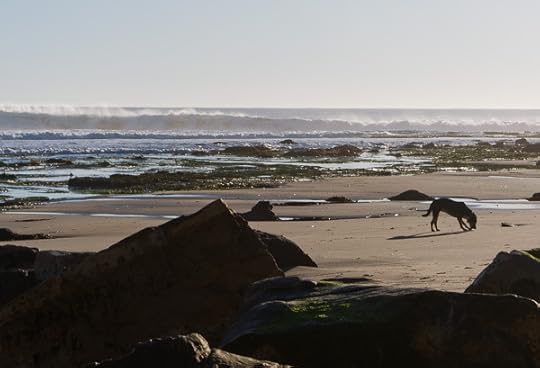
Is there any cost to putting the album cover into every file as metadata? Yes, the file gets bigger. A typical album cover image of good quality is going to run you about 200 kilobytes. And you can look in your Music directory and see that the a given mp3 music file gets 200 kb larger after you add the album cover image to its metadata. Doing the math, if you have a library of, say a thousand tunes, then putting album art into each file makes your library 200,000 kilobytes larger, which is 200 megabytes, or just under a quarter of a gigabyte. In a nutshell, it costs a quarter gig per thousand files to put art in every file. If you're loading up with four thousand files, the covers cost you a gig.
This isn't a problem on my iPhone, which has 32 gigs of storage. But it is a problem for my 8 Gig iPod Nano. It's a sneaky problem too. To keep the size down, I have a playlist called "Rudy's iPod Nano," and I only copy that to my Nano. But then iTunes might tell me that the playlist is 6 gig in size. But when I go and try and synch this playlist to my 8 gig Nano, the synch won't work, because there's not enough room. That's because iTunes only told me the size of the audio part of the tracks. You used to be able to get around this by telling iTunes not to put album art on a given device, but I don't see that option anymore. So for now, given that I do want the art on my iPhone, I just live with slightly fewer tracks on my Nano.
Not that, in reality, I often look at either music-player's screen.
Up Next
One final tip. When you get the files in your Music directory nicely organized, and with good metatags in place, savea back-up copy of the full Music directory to another folder or to another drive. It's really easy to lose a great deal of your hard work with an ill-considered click on tools as powerful as iTunes and iTsfv.
Okay next week or the week after, I'll post about "Ripping Vinyl to iTunes for Free".
Enough of this for today! Hope some of this is useful to some of you.
Managing Music in iTunes for Free
This year I made a simple New Year's resolution. I'd finally rip my vinyl to digital files. I've got a few hundred favorite old LPs in my living room, and I want to hear them on my iPhone.
I've been embroiled in this for a couple of weeks, and I'm going to write (at least) two heavily geeky posts about it. The first post, "Managing Music in iTunes for Free," is on the more general topic of organizing your music in iTunes. And the second post, "Ripping Vinyl for Free" will be about the related process of copying vinyl records into iTunes for use on your music player.

[Today's long post is illustrated with a sequence of non-computer-related photos that I took around Los Gatos and Santa Cruz today. It's been raining a lot lately, and now the sun is out, and today it was like a cool spring day.]
Let me reveal in advance that I'm a Windows user, and I am not a huge fan of iTunes, in terms of its feature set, user interface, speed and responsiveness. Ever since March, 2010, I'd in fact been getting by with using the Windows Media Player (WMP) in addition to a commercial plug-in that let me synch a Windows machine with an iPod. In some ways WMP really is a better tool than iTunes, but I'm not here to argue about that today. Nothing's perfect. [This pops into my mind a remark by Randall Jarrell: "A novel is a prose narrative of some length that has something wrong with it."]
In any case, my old setup wasn't compatible with my new iPhone 4, also there are a number of other things (like apps) that you need to synch with iTunes onto your iPhone. So I'm back in iTunes. Oh well. I've been around this track a few times before. And iTunes does have a pretty interface, that album-flip thing is cute. And I have to use it with my iPhone. So I might as well learn how to do it right. So I can rip my vinyl.

Over the years, and more so in the last two weeks, I've learned a few tricks about managing your music in iTunes. This information is not all that easy to find online. When you look for it on Google, most of the top-page links are to sites promoting feeble, kludgy commercial software. I downloaded trial versions of a few of these, and didn't like them. They were slow, not all that good at what they were supposed to do, and they wanted, like, $39 to keep working after 100 songs.
With a little digging, I found out how to do everything I needed for free. So I thought I'd note some things here, if only so I can easily find the answers when I've forgotten them in a year or ten. I am not going to mention or plug any commercial software at all in my two posts. And for that matter, I plan to remove or block any mentions of commercial wares from the comments on these posts. Real info from the people and for the people.

I find it useful to have a mental model of what's going on inside the machines. I think of there as being three different sources of information about the music when you use iTunes.
(1) The directory structure of the audio files saved on your hard drive.
(2) The internal data base that iTunes builds. You can't see the database directly, but you see it indirectly in terms of what's displayed in your iTunes window.
(3) The "metadata" tags embedded in your audio files. These so-called ID3 tags hold info like the song title, the artist, and possibly an image of the album cover.
In the rest of this post, I'll make some comments about each of these three.

(1) Music Directory
I'm suspicious of non-open file standards like the Apple (default) AAC format. So I use the open MP3 format. A win with MP3 files is that you can find good freeware editors for tweaking their metadata fields—which we'll get into later on.
Do note that the iPhone, iPad, and iPod play MP3 files just as well as they play audio files in the proprietary Apple AAC format. There is absolutely no downside to using MP3. If you want to convert existing AAC files to MP3, you can often do this using iTunes.
Or you can just switch to importing future files as MP3, and plan to work with a mix of the two kinds of files.
You set the rip and import as MP3 choice on the Edit | Preferences | Import Settings. Set it to MP3, and for the Setting, choose Custom…, which opens a dialog. The kps number determines how many samples per second you make of the music stream. In the old days I used 128 kps, but now I pick 256 kps, and turn on Variable Bit rate (which saves a bit on file size by using less bits on the simple parts of the songs) and choose Medium High or High for the VBR. We're edging towards terabyte memory storage, and we can be generous.
It's not useful to have your music files hidden somewhere invisible inside My Computer's Settings files. You want your music files in an easy-to-find location so you can look at them, copy them, and, if you're of a tweakerish nature, edit the file structure by hand. I make, say, a C:\Music directory on my hard drive, although I can put the directory somewhere else, too. I tell iTunes about this on Edit | Preferences | Advanced | iTunes Media folder location, where I set the iTunes media folder to be me Music folder. iTunes will store a few other things in there, but that's okay.

Still in the Edit | Preferences | Advanced dialog, you might as well leave the checkmark on the option "Keep iTunes Media folder organized (Places files into album and artist folders, and names the files based on the…song title)" This means that when, for instance, you rip a CD like Joe Moon's Howling, iTunes will store the MP3 tracks of the CD in a folder like Joe Moon\Howling that goes into the Music directory.
Note, by the way, that compilation albums, that is, albums with songs by a variety of people, are all stored in subfolders of a Compilations folder.
If you've edited your Music folder by hand—perhaps adding some files yourself, or moving the entire directory. or if you've just recently set it up—you need to tell iTunes to import it, so the information goes into the data base. This is simple. Use File | Import Folder to import the Folders that you've changed. Doing this is almost instantaneous. It may, however, change the directory's name or some of the filenames, although normally not in a bad way.
Many people don't in fact look at or fiddle with the subdirectories of their Music directory and, quite honestly, you don't really need to do it. So the rest of this is optional reading.

[Begin ultrageeky optional info] Sometimes when you import a CD, iTunes will mangle the name of the artist or the label, in particular the "&" and "/" symbols are often replaced bye "_". If you feel like it, you can later go and change the directory names in the Music directory, although it's probably better to put "and" in place of "&" and "/" so as not to provoke iTunes. Occasionally, iTunes will split a single CD across several directories. You can copy all the files into a single directory and delete the extra ones. And if you import the changed directory, iTunes will normally leave it as it is, even with the "Keep iTunes Media folder organized" feature on. It normally only changes the names of directories and files that
Keep in mind that every time you've edited your Music folder by hand, you need to tell iTunes to import the folder again. Doing this may sometimes change the directory names and the file names in your Music folder. At some point you just have to let go.
One very nice result of the "Keep iTunes Media folder organized" feature (significant for vinyl rippers) is that if your track happens to have an ID3 metadata tag with track name information in it, iTunes will in fact change the mp3 file in your directory to have that name. So if, for instance, your file initially has some random useless name like 01-s.mp3, but the metadata tag says the track is called Vicious, then iTunes changes that file's name to Vicious.mp3. If your track has no metadata, then iTunes leaves it's original file name.
I find it best stay away from the File | Library | Consolidate action, which is about the same as importing the whole Music folder. Once you get the files and directories named the way you like, and everything looks good inside iTunes, you don't necessarily want to risk having things renamed again. And don't use the File | Organize Library | Reorganize files option, which will copy the contents of your Music folder to a Music\Music subfolder.[End ultrageeky optional info]

(2) Music database
As I said, you don't directly see the iTunes database, but you see the effects of it in the display. There are two kinds of issues here. One kind of issue has to do with the database being in some way out of date. The other kind has to do with the "metadata" or ID3 tag information inside the music tracks. I'll talk about the music metadata in section (3).
If you've tweaked your Music directory and re-imported it, is that some songs may appear twice in the iTunes database, but one of the entries will be a "dead track" that is, a link to a no-longer-existing directory location. Or if you hand-deleted a folder of songs, then all those references will now be "dead tracks" in iTunes.
These entries will sometimes have an exclamation point icon next to them on the left in the iTunes display. But the exclamation point tends not to appear until you try and do something with the track, so they're not always easy to find. And deleting them by hand is a drag.
I found an easy fix for finding and removing dead tracks by Paul Mayne. Scroll down in his post to the September 2009, update, where he explains how to do it with two playlists, one smart and one static.

(3) Music metadata
This is one of the biggest time-sinks involved in managing your music files. Each audio track has some fields of non-music data to hold such things as the album name, the album artist's name, the track name, the track artist's name, and possibly a jpg image of the album cover. These are often called ID3 tags.
Generally you will already have some tag information in your audio files—unless you've ripped your file from vinyl, but I won't get into that yet today. With tracks ripped form CDs or downloaded, you'll normally have tag information. But you may need to adjust it.
iTunes itself lets you edit the tags. You can highlight a track and press Ctrl + I in Windows (or Apple + I on a Mac) to open the Item Information dialog. (Or, in Windows, you can right click on the track and select Get Info… Or you can use the File | Get Info… menu selection to open it.) It's also possible to open a dialog for Multiple Information Dialog, which looks a bit different. You open this guy by highlighting several files at once with your mouse, and then one of the methods mentioned above to open the Get Info dialog. Whether it's one file or multiple files at once, you can edit the tags in these dialogs. The tags will be on the Info tab of the dialog

Okay, so what do we use these dialogs for?
Sometimes you have orphan tracks that are listed as belonging to Unknown Album by Unknown Artist. You need to open up the Information Dialog for these poor tracks and fill in the info. Where do you get the info? Often you will in fact know this information, or be able to deduce it from listening to the track. Or you can ask iTunes to find the track info, but often as not, it snottily refuses to do this, saying that you didn't import this file via iTunes (meaning, I think, that you didn't buy it from Apple). Or you call up the individual Information Dialog for a track and see the name and location of the file for this track on your computer, and often this will help. I won't get into the possibility of using audio-sample based search engines just yet.
Another common problem is that a single album is split into two or more separate albums in iTunes. I found the answer in the Apple Support forums, a well-moderated non-spammy spot to look. Make sure that all the tracks in question have the identical information regarding Album Artist and Album. To do this, highlight all the tracks that you want to have on a single album, open the Multiple Information Dialog, and type in a chosen name for the Album Artist and a chosen name for the Album.
Normally this immediately merges the two blocks of album listings together. If it doesn't merge you might make sure that there aren't some field other than the individual song tracks that differ. Now and then I've seen the Compilation field set to Yes in some files and No in the others, and I need to uniformize this.
Note that you can pick the names of your artists and albums. Artists sometimes use different names, and it can be useful to adopt one default spelling. Or you might want to just list a group by the name of the leader.

Another issue is that album names are often too long to view on your iPod, names like Zappa's You Can't Do That On Stage Anymore Volume 5 Disk 1. I like these albums, so I gave them all names like On Stage 5-1 and On Stage 5-2. While I was at it, what the hell, I changed the album names from On Stage 5-1 and On Stage 5-2 into a single "album" (as far as iTunes can perceive) name On Stage 5.
I do all this inside iTunes by changing the tags, you understand, it doesn't have any direct connection to what lives inside my Music folder.

Another problem is that a compilation album like O Brother Where Art Thou may end up listed within iTunes as if it's a whole lot of different albums. In this case you need to tell iTunes that the tracks do belong to a compilation album. There is a setting for this in the Information Dialog that call up when you highlight some tracks with the Get Info command. Make sure that every track in a compilation album has Compilation set to Yes, and that the Album Artist field is either blank (in which case iTunes will supply the "Various Artists" name) or is, if you like, set to the name of the album's compiler, as in Richard Scorsese's Blue's Collection.

I haven't yet mentioned the missing piece of metadata that concerns us perhaps the most often: the album art. To begin with, you can ask iTunes to search for the album art. And it will do this provided you have a free iTunes store account. Running the search several times often produces slight improvements. But, at least for me, there's usually about ten percent of the albums that don't get covers, or that get the wrong covers.
There are a number of commercial products that say they'll find the album art for you. But actually it's very easy to fix it yourself. Just do a Google Image search with the album artist and name in the search box. You'll find hundreds of images of the cover. Pick a decent-looking one, but don't go overboard in terms of size, about 500 pixels across is usually going to be enough. Copy the image from the Google search page—I use a right click and a Copy Image to do this, but you can do this other ways. The image is then on your (invisible to you) clipboard.
Then, back in iTunes, use the Get Info command yet again to open up the Information Dialog, find the box to hold the album art, and paste from your clipboard with a right click and Paste command, or Ctrl + V or an Apple + V.

The default behavior of iTunes is to attach the album cover image as metadata to only the first track on the album. And then the album cover image appears in the iTunes browser next to the album's tracks. And by default iTunes doesn't put the image into the other tracks.
When you copy your tracks to an iPod or an iPhone, however, the "album group" info is ignored, and every track has to fend for itself in terms of providing an image of the cover of the album it came from. So often only the first track of the album will show a nice picture on the iPod or iPhone, and the other tracks will just show a gray note.
You can preview this behavior in iTunes by pressing the fourth button from the left on the bar at the bottom of the screen. This is the "show or hide item artwork" button. If you turn it on, you see a picture of the cover in the lower left corner of the screen…or a gray note.
Lapsing into Windows keys info here…If one track has an image but the others don't, you can right click on the artwork image and select Copy. Then select all of the no-artwork tracks from that album (using a left click and a Shift + left-click to select a sequence of track names). Then press Ctrl + I to open the Item Information dialog or the Multiple Item information dialog. Then right click on the empty artwork box at the bottom right of the dialog box and press ctrl + V to paste it in, or right click and select Paste. Don't do this more than once, however, as you'll end up pasting in the file twice.

Is there any cost to putting the album cover into every file as metadata? Yes, the file gets bigger. A typical album cover image of good quality is going to run you about 200 kilobytes. And you can look in your directory and see that the file gets 200 kb larger. Doing the math, if you have a library of, say a thousand tunes, then putting album art into each file makes your library 200,000 kilobytes larger, which is 200 megabytes, or just under a quarter of a gigabyte. In a nutshell, it costs a quarter gig per thousand files to put art in every file. If you're loading up with four thousand files, the covers cost you a gig. That's probably okay on a modern device. Or you can not put the covers into every track, and live with seeing the gray note on the MP3 player screen. Not that you actually look at the screen all that often anyway.
Okay next week I'll post about "Ripping Vinyl to iTunes for Free" and will also mention a bit about a nice free tag editor I found named Mp3tag…this editor is also pretty good at finding album art by the way, although nothing works as well for album art as Google image search, IMHO. (And when I say "free" I mean in the old sense of "not costing anything to get and working forever without ever asking for money.")
Enough of this for today! Hope some of this is useful to some of you.
December 29, 2010
Post Xmas
I got an iPhone for Xmas, and I've been playing with it a lot.

My first photo with the iPhone, heavily Lightroom-treated to "fix" it. Me and my skug. (But which is which?)
I put about 10 Gigs of music on the iPhone, and am now dreaming of ripping all my old vinyl records, which would take days. I converted a bunch of my photos to the native iPhone image size of 900 pixels wide or high, at 326 pixels per inch (!?) and used iTunes to put them on the iPhone. I even found a site explaining how to put my manuscripts on it in E-Pub format, not that I'll ever look at them, I don't think.

And I got some apps. I'd been to an "augmented reality" conference in 2010, so I was especially interested in augmented reality apps, that is, apps in which a live video image of the world is overlaid with information or with game elements.

[UFO disguised as a princess cake.]
My favorite among these is AR Invaders. You see UFOs flying across your sky, or, for that matter, around your living-room. And you shoot them, twisting wildly back and forth to see them all through your iPhone screen. My son Rudy was really into it. "There are so many UFOs in here," he said. "And nobody else can see them."
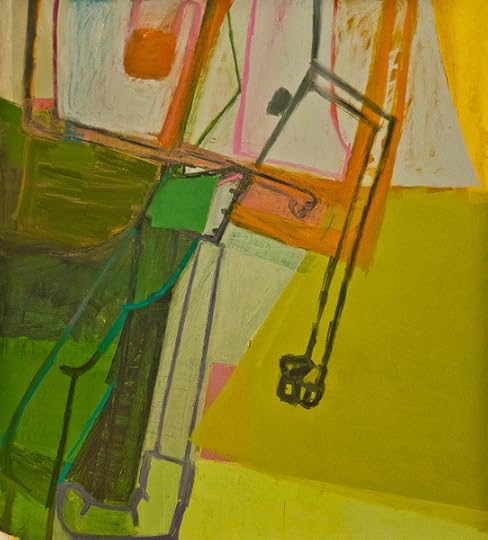
My family and I were in the SF MOMA for about twenty minutes the other day—no longer than that, as we had four young children in the party. On the top floor they had a show of recent art. It's rather rare to see any real paintings at all in an art show anymore, but there was a good one by Amy Sillman, "US of Alice the Goon." I found a lot more of her paintings online with a Google image search.

I also saw a weird video by Ryan Trecartin. You can find a lot of his work online at this great avant garde art site, UbuWeb.

[This is the only other iPhone photo I'm posting today, all the others are from my Canon S90. This is just a picture of a folded blanket, and should not be confused with the story line in Duane Michal's ribald photo series, "Take One And See Mt. Fujiyama."]
The iPhone camera is, as my nephew Embry puts it, "a nasty little camera." I am getting better at using it—learning to tap on the screen to focus, and to zoom in a little bit to reduce the fisheye effect. I tried some photo apps, including Hipstamatic and Camera+, but neither of them really seems to improve such basic weaknesses as speckling and distortion. You can fix a little of that in Lightroom, but, really, that's kind of a waste of time—if you want a nicer looking picture, you want to use a nicer camera. The iPhone camera is handy, though, and it's fun for making videos to be viewed basically only on the phone.

Speaking of cameras, I read an interesting article about digital camera sensors in the New York Times the other day. I like this article because it speaks favorably of the Canon S95 that I'm using as a pocket camera these days (well, actually I have last year's model, the S90). These guys have larger sensors than generic digicams, although not as large as the high-end SLR digital ones.

What else? My article "Lifebox Immortality" is on the h+ Magazine site.
Now for New Year's Eve and Day.
December 22, 2010
A Dispatch From Interzone
Have a great holiday! This is a long post, with some stuff to read, it may have to last you till 2011…

This month I made some imaginative efforts and finished the next chapter "Dispatches From Interzone" of my novel in progress, The Turing Chronicles. As I mentioned before, I wrote this chapter is in the form of letters from my Beat hero William Burroughs, some samples of which I put in my post, "Burroughs Letters, Tangier 1954-1956."
Molding an SF action-novel out of William Burroughs letters is like collaging a landscape out of frames from the Sunday funnies. And I had to draw all those wacky little frames too. Or it's like building an epic out of haikus. But I like the way the chapter came out. It's funny, I think, and deep as well. You can read an excerpt down below, at the end of this post.
[image error]
Right now I'm unsure of the upcoming story arc. To some extent I'm back where I was a month ago, when I wrote my blog post, "Skuggers"
It's daunting how many scenes and ideas a novel needs. But I don't have to write the whole novel at once. All I need now is to write the next chapter. So now what I need is to outline Chapter 8 fairly well, and also get some clear idea of what happens in Chapter 9. And the chapters after that will take care of themselves.
It's a long process, after all. And there's no rush. But that's not exactly true. My sense is that I don't feel as if there a rush, then I might not drive myself hard enough to actually finish the book. Onward!
No, wait, Christmas comes first.
[image error]
Anyway, in my "Dispatches from the Interzone," chapter I did indeed get Burroughs to organize a trans-Atlantic skugger-star teep antenna, as I'd planned to. By the end of the chapter the construct falls apart and the individual skuggers go their own ways. And this is as it should be, because it would be too much of an onus for Turing to have a skugger-star tracking him on his road trip to Los Alamos.
It'll just be regular cops chasing Alan, although, for a while, there will be more and more of them. We'll see an ongoing attrition in the forces of control, as more and more of them will be converted into being skugs.

I realized today, it's as if I'm telling the story of The Invasion of the Bodysnatchers, but I'm telling it from the p.o.v. of the pod people, and I'm viewing these alienated mutants as a positive force. Which is, after all, precisely what happened culturally as the 1950s segued into the 1960s.
If near the end of the book, I have Turing pulling the skugs up into a higher reality, it vaguely correlates with Tim Leary lifting the hippies out of politics and into Lotus Land.
And what happened then in the real world in terms of the culture wars. What aspect of reality might I transrealize into Turing's final move?
[image error]
I'm thinking of the internet as being the thing that resurrected political action. And it could be that Turing starts manifesting himself via the web. I could even go transreal for the last couple of chapters, and insert myself as an authorial character, getting messages from Turing in "real time." Like there's an astral blog site that only I and a few privileged others (such as the readers of this blog), can see. Maybe I'll give you the URL in 2011…
Meanwhile, here's an excerpt from the latest chapter. Burroughs is a skugger now, that is, a shapeshifting, mildly telepathic host for a symbiotic skug. And the British Embassy has engaged him to turn a basement filled with 64 captive Arab skuggers in Tangier into a telepathic antenna for tracking Alan Turing, who's escaped to America. He knows one of the skuggers already, a youth named Driss.
[image error]
The second day, Driss and the fellahs tell me they're edgy at being in police custody. Only a few of them speak English or Spanish, but our short-range teep is working. The skuggers don't wanna play ball. So I get the Embassy stooges to haul down a fifty-pound bag of refined white sugar. Everyone in the pit start feeling friendly.
The third day I double the sugar ration, and slime out some tentacles from my fingertips, plugging every navel in the room. Puppetmaster Bill. "Let's all get soft," I propose, teeping sexy images of mollusk reproduction. I chant whatever gone strophes come to mind, also feeding the skuggers' real-time reactions into the mix. Feebdack feedback. The locals are easy-going people, if you give them a chance.

On the fourth day, even more sugar, also a carboy of olive oil. Everyone feeling festive—we shining and sticky with the sweet slick. I push my face against Driss's so our heads merge. Plup! Feel real wiggy. I use my squiddy arms to gather ye rosebuds. And then we're a starfish with a shared yubbaflop head on the Embassy basement floor, like the center of a wagon wheel.
I grow out a feeler with a lobster-eye to admire what we done. Our group face look like a gangland hit on President Eisenhower, a bald baby with slit-mouth scars and eye-puckers like bullet holes. Hopper and his boss upstairs are abreast of our session, they very pleased.
On day five, I engage three footmen to haul in hods of wobbly British pastries, barrows of dates, heaped trays of kumquats. The skugger fellahs are increasingly glad to see me. Great cheers. "Booo-rows! Booo-rows! Booo-rows!"
Driss and I plup our heads together, the rest of the gang piles on. We make a parabolic monster face, a dish-shaped teep antenna pointing towards the floor. We vibe our mind-rays through the watery gut of Ma Earth. You wave, we wave. Hopper is run a droopy tentacle down the basement stairs into my spine.
And then—lo! We pick up on Turing in Florida.
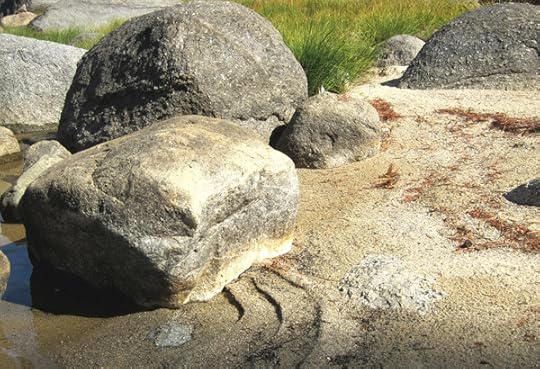
Happy X and a Great Y!!!!!!
December 18, 2010
Ready for Holiday Fun
Raining here this week. I love the rain. Everything gets green, including the moss on the trunks of the oak trees.

My son Rudy put a skylight in his living-room. It doesn't leak!

I'm playing with Lightroom all the time. Used a blue filter on this color picture to kill the overbrightness of the light fixture.
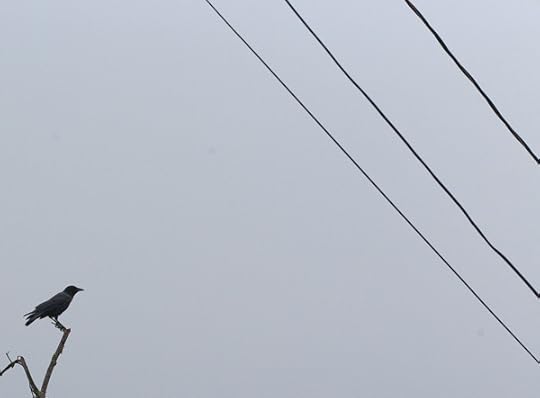
I'd like to be reborn as a crow. People used to imagine that animals work really hard to get enough food each day. Turns out, they can fill up with about an hour or hour-and-a-half of pecking. The rest of the day is for hanging out. Cawing and flapping. And no computers.
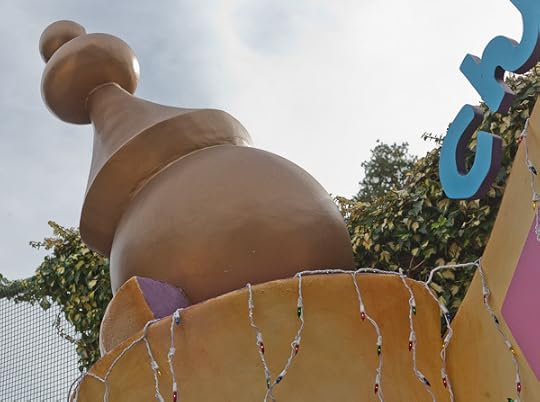
We took two of our grand-daughters to this funny old place in Oakland called Fairyland this week. It's very much a home-brew folk-art construct. When I was a boy in Kentucky, there were lots of places like this. Disneyland didn't exist yet.

We even saw a puppet-show of Cinderella. I always wondered about the glass slipper. Would it be comfortable?
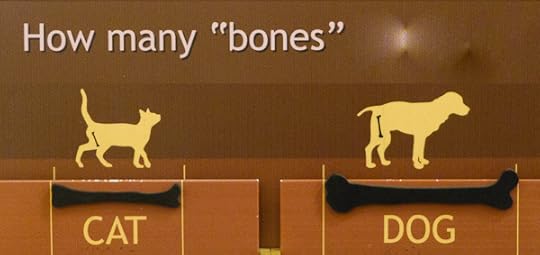
We hit a science museum the week before. "How many bones?" This sign made me laugh, remembering an Underground comic strip years ago that started off, "I'd just smoked two big bones of the good old green and…"
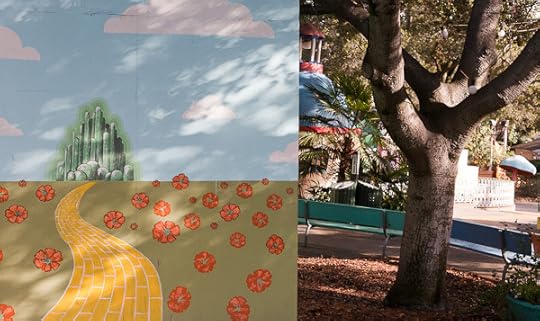
The year's dwindling down. Around this time it gets to be hard to remember what day of the week it is. The calendar breaks and falls apart. And we take a little rest among the ruins of the decaying year, making merry with our relatives and friends.
December 13, 2010
Chatbots. My Lifebox.
Yesterday I met an interesting couple, Bruce and Sue Wilcox. Their chatbot Suzette just won this year's Loebner Prize for doing the best job at the Turing Imitation Game, that is, the game of the chatbot program trying to convince a human judge that the chatbot is human too. They talk via an instant-message interface. If a program could reliably and consistently win at the Imitation Game, we'd be included to say it had achieved human-like intelligence. Looking at the chatbot site describing Suzette, I was surprised to see how widespread and popular this programming exercise has become.

I've always thought it telling that in Turing's 1950 article proposing this test, he begins by talking about a different kind of test—in which someone interrogates subjects via instant-messaging and tries to decide whether they are male or female. I've integrated my thoughts about this into my novel in progress, The Turing Chronicles, in which Turing does in fact impersonate a woman.

The dapper and fanciful writer Mark Dery has a new essay online, "Hate is All Around: The Politics of Enthusiasm (And Its Discontents)", and near the end he mentions my writings about my concept of the lifebox.
[image error]
Given that I'd been talking about the lifebox with the Wilcoxes last night, reading the Dery article today was enough of a push for me to finally make an alpha-release version of a lifebox on my new Rudy's Lifebox page. What's a lifebox? Quoting from the new page:
I go into considerable detail about the lifebox in my novel,Saucer Wisdom, in my non-fiction book, The Lifebox, the Seashell, and the Soul, and in my 2009 article "Lifebox Immortality & How We Got There" which I co-authored with Leon Marvell. In a nutshell, my idea is this: to create a virtual self, all I need to do is to(1) Place a very large amount of text online in the form of articles, books, and blog posts, and (2) Provide a search box for accessing this data base.

And you can find the search box on the "Rudy's Lifebox" page. The reason it functions like a chatbot emulating me, at least a little bit, is that I have, over the last ten or fifteen years, placed really quite a large amount of my writing online.
[image error]
But it's still not going to write the next chapter of my novel for me, or draw a new view of Mount Fuji.
Another day wasted? Well, maybe not. Rudy's Lifebox can function as a partial replacement for my fading memory. Remembering there was something about this in a book, Be Not Content, that I love, I entered be not content waste time into my Rudy's Lifebox search box, and found this from an old blog post of mine:
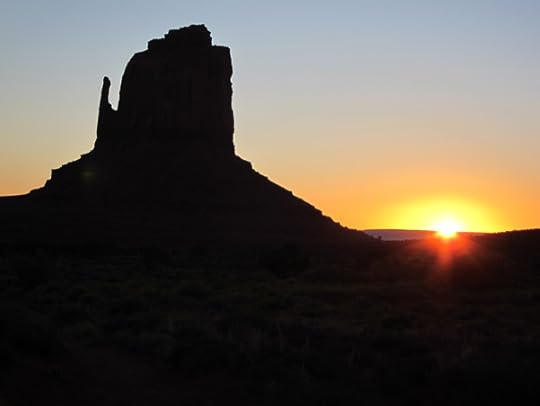
I'm always worrying about wasting time, right, and I saw a great line in Be Not Content, the author-narrator Abel Egregore expresses this fear to one of his stoner friends, who guffaws, "Time? How can you waste time?" And I get a little enlightenment there. Time and space, the all-pervasive ineluctable modalities. What's to waste? You use one second per second no matter what you're doing. A wonderful teaching.

And—we decorated our Christmas tree today!
December 11, 2010
Photos. John McLaughlin. Distraction.
The other day, I posted a lot of photos on my Flickr, I put the best shots of the last ten months or so into a collection, "2010 March-Nov". In a sharing or deluded mood, I uploaded most of them at rather high resolutions—and I don't feel like going back and changing this, so feel free to sample and print from there for private use, although I am still maintaining copyright over the pictures. If you want to buy a ready-made print, I have a lot of my photos on Imagekind as well.

I'm going to try and keep my Flickr photostream and my Imagekind gallery a little more closely in synch with the photos I put on the blog, so in general, you might find larger forms of the images there. Adobe Lightroom is making my photo-juggling a lot easier—with the downside that I'm spending more and more time doing it, even running outside and takiing more photos just so I have more raw material to work with. "Like a picture of a water fountain? You kidding me?"

I've been frittering away increasing amounts of time on delusional web activities like Twitter, Flickr, Imagekind, my blog, my email, Wikipedia research, my paintings website, free ebook releases, my book websites—it's a little alarming, really. At some point I'll cut back. "Only not today."
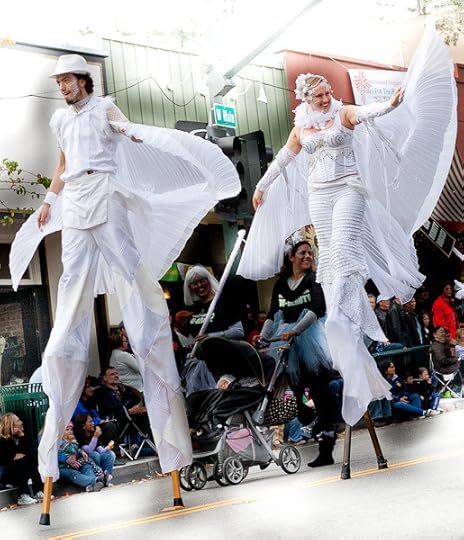
Really, I get much more pleasure out of actually writing, but by now there are so many ways to avoid writing when I have my computer on.
When I remember to be an author, these days, I'm into writing my second chapter of fake William Burroughs letters. It's an odd mind-set, to be using such a particular and quirky format to create text that advances the plot of a science-fiction novel. Like making a portrait out of collage snippets.

But certainly Burroughs himself did often think in terms of having his novel Naked Lunch or Interzone (as he called it) be SF. The juxtaposition seems odd in 2010, because, over the years, SF has ossified into a somewhat rigid genre, and the more literary or experimental kinds of work get classified as something else. Speculative fiction. But I generally still see publishing my novels as SF in a positive light. It gives access to a certain level of distribution and readership.

[Some cellular automata "Nested Scrolls" made my Capow software.]
We went and saw John McLaughlin and his group The Fourth Dimension at the Rio Theater is Santa Cruz last night. It was lovely music, sweet, rocking, and somehow spiritual. Sylvia noted a large number of men with gray ponytails in the audience. We first saw McLaughlin with a double-neck guitar and the Mahavishnu Orchestra about 40 years ago, in Princeton, here's a video from that time.
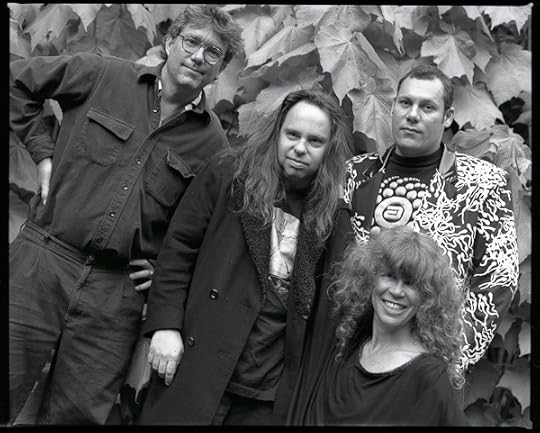
Speaking of earlier times, here's a photo from 1992, right before the appearance of The Mondo User's Guide edited by me, R. U. Sirius, and Queen Mu, and designed by Bart Nagel, who's wearing the flashy "sperm jacket". The photo was taken either by Bart using a timer or, I think more likely, by Mondo staffer Heidi Foley during a photo shoot by Time magazine. Thanks to Bart for sending me this photo.

Coming back to my concerns about wasting time on the web, a good benchmark of where I'm at is the kinds of things that I think about while I'm at a concert. It's an ideal chance to space out and the mind roam. Sometimes, more commonly with rock, I manage to get so deeply inside the music that there's nothing else. With McLaughlin, there's some chance of a meditative state—for me, he often evokes the mental image of being in outer space free-falling into a giant star. But I noticed that last night, I was spending more time than I wanted in thinking about how to promote my writing and images on the web.
[image error]
Once again it's time for a walk in the woods.
Rudy Rucker's Blog
- Rudy Rucker's profile
- 583 followers




